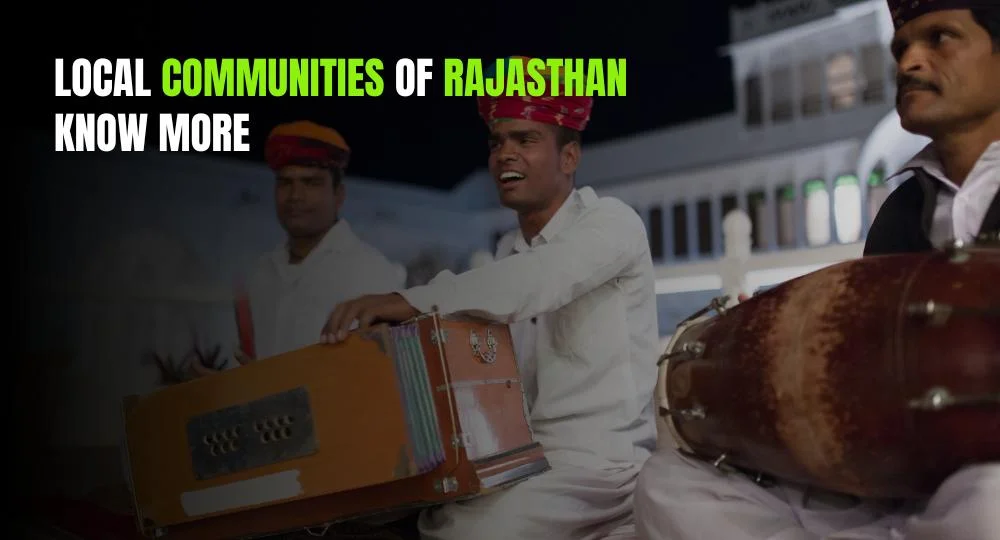Exploring the local communities of Rajasthan isn’t just about seeing a place; it’s about feeling the heartbeat of the people who have lived there for centuries. Sure, you might think of grand palaces and massive forts when someone says “Rajasthan,” but the real magic? It’s in the villages, the small towns, and the everyday life of the people there. This is where you see the real Rajasthan — raw, colourful, and deeply connected to its roots.
Let’s take a journey, not through the lens of a perfect travel guide but through the eyes of someone just experiencing the real Rajasthan.
The Cultural Melting Pot of Rajasthan
Rajputs: They Aren’t Just Warriors
It would be remiss of you not to bring up the Rajputs when discussing Rajasthan. Of course, everyone is familiar with their regal status and heroic deeds, but that’s not all there is to them. Meeting a modern-day Rajput household is like entering a time capsule. Their traditional principles of honour and pride are still very much alive and well, but with a contemporary twist. By the way, have you seen how they manage to keep both the past and the present in harmony? You won’t find anything like that in any movie or textbook.
They talk about kings and battles all the time; it’s not just a story. Over tea, I once sat with a Rajput family and we didn’t feel alienated at all while we spoke about their ancestors. Their conversation seemed to be about distant cousins who lived only a few decades ago. When you experience history in these little, everyday ways, you really feel a part of it.
Know About – Best Places to Visit in Rajasthan during Diwali
Bhils: Tradition in Every Breath
As one of the world’s oldest indigenous communities, the Bhils have managed to preserve a way of life that seems frozen in time despite the rapid pace of modernisation. However, not in a retrograde manner. It seems more like they’ve discovered contentment with life’s natural cadence. When you visit a Bhil village, you’ll see that the land is vital to their way of life. In a fast-paced society, it’s not often that you find people whose daily lives are so intertwined with nature, as they are in agriculture, hunting, and fishing.
Even though we didn’t share a common language, I had an unconscious understanding with an elderly man I met in a village close to Udaipur. How much you can pick up from mere observation is mind-boggling. Their treatment of animals and crops is characterised by extreme reverence. As you leave, you can’t help but wonder if, in our rush for progress, we have sacrificed something essential.
Also Read – Jaipur vs Udaipur – Comparing Two Jewels of Rajasthan
Meenas: Not Just Farmers
Now, the Meena people are commonly known for their exceptional farming abilities. And yes, they are superb farmers, but that is far from all they are. Not only that, but the Meenas have legendary folk songs and tales that have been handed down through the ages. The music, festivals, and strong sense of community in Meena village make it more than just a place to visit.
I had the good fortune to go to a nearby event once. No elaborate staging or spectacular performances—just a crowd of people singing and dancing as if it were second nature. Plus, it wasn’t a show for outsiders; it was a sacred ritual honouring their forefathers and deities. You won’t find that kind of genuineness in a manual.
Know more about – 25 Honeymoon Places in Rajasthan
Garasias: Keeping It Real
The spiritual and natural worlds are intertwined for the Garasia people. Spending a few days in their Sirohi village taught me so much about them; I had no idea. The way they honour their forefathers makes it seem as though they are still very much with them. Neither the village nor its entire belief system makes you feel more than a guest.
Did they dance? I can’t believe how lively they are. Not caring if my dance skills were perfect, I joined in because I wanted to feel like I was a part of something greater. This is the kind of thing that makes you realise that travelling isn’t just about seeing the sites and checking things off a list. It’s all about emotion, and during those little moments, I felt energised and at one with the world.
The Festivals that Unite Rajasthan’s Local Communities
The Camel Fair of Pushkar
Held annually in the sacred town of Pushkar, the Pushkar Camel Fair is among the most well-known celebrations in Rajasthan. It’s more than just a show for the locals, it’s a huge draw for tourists. Traders and farmers from all over Rajasthan gather at the fair to buy and sell cattle and take part in exciting cultural events.
The Pushkar Camel Fair showcases Rajasthan’s long-established agrarian traditions and the vital role that livestock plays in the state’s economy. In the exhibition, traditional camel herding communities like the Raika and Rabari take the stage, demonstrating their mastery of camel breeding.
Gangaur: Celebrating Women and Harvest
Gangaur is another prominent festival observed by Rajasthan’s rural populations, notably women. It’s a festival honouring Gauri, the goddess of fertility and prosperity, and commemorating the start of the harvest season. During Gangaur, women around Rajasthan dress in their finest apparel, march in processions, and pray for the well-being of their families.
The festival is a highlight of Rajasthan’s cultural calendar, celebrated with tremendous fervour in both rural and urban areas. It also serves as an opportunity for the various local communities to gather and celebrate their shared heritage.
Read more – Local Festivals to celebrate in Rajasthan
Handicrafts: A Legacy of Rajasthan’s Local Communities
The Blue Jaipur Pottery
Out of all the Rajasthani handicrafts, the Blue Pottery of Jaipur stands out. The Mughal artists brought it to the region from Persia, where it is thought to have originated. Local Rajasthani communities eventually embraced the art form and gave it its unique spin. Blue Pottery is now a representation of the creative legacy of Jaipur.
Must Read – Best Shopping Places of Jaipur
Bandhani: A Tie-Dye Masterclass
Bandhani, often known as tie and dye, is another well-liked art form in Rajasthan. The skill of using the tie-dye technique to intricately design fabric designs has been handed down through many generations of craftspeople. People from the Chhipi community in the villages around Jaipur and Jodhpur are well-known for their Bandhani skills. Traditional Rajasthani garments, such as sarees, odhani, and turbans, are crafted using this art form, which is an integral aspect of the state’s textile sector.
Preserving the Heritage of Rajasthan’s Local Communities
Rural Rajasthanis are not only the keepers of a priceless cultural legacy, but also of time-honoured customs that are vulnerable to the pressures of progress. There are a lot of government and non-profit programs that are trying to help these people by boosting sustainable tourism, traditional livelihoods, and handicrafts.
The indigenous people of Rajasthan have maintained their distinctive arts, cultural practices, and ways of life despite the numerous changes brought about by modernisation. The traditions and stories of these communities give Rajasthan its unique character and make it an unforgettable place to visit.


